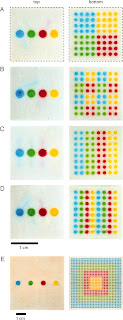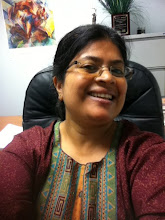It is eminently clear that for diagnostics to work effectively in the developing world, they have to be cheap, rugged, lightweight, portable, and work without needing additional infrastructure. Well, what could be simpler and cheaper than paper and scotch tape?
The laboratory of Professor George Whitesides at Harvard University has generated a prototype “lab-on-a-chip” microfluidic device, made out of water-absorbent paper and water-repellent double sided scotch tape. Microfluidic devices, simply put, are devices composed of channels that conduct fluid from a given point of application to one or more location(s) where some event (e.g., a chemical reaction or an enzymatic action) takes place. These devices are often made from glass or other polymers, and frequently use external pumps to conduct the fluid through the channels.
In this unique new design, the Whitesides group has used the natural absorbance of paper (and its ability to “wick” fluid), along with the water repellent nature of scotch tape to create a diagnostic lab-on-a-chip. Each stamp size device is composed of several alternating layers of paper and tape. The paper is first treated with a photoresist material in a micropatterned fashion using a mask (the photoresist material makes the paper in the treated parts water repellent). This results in the creation of channels that funnel liquid (such as test urine or sputum). Two adjacent micropatterned paper strips are separated by water-repellent scotch tape, where tiny holes punched in the tape serve as conduits for the liquid to flow from one paper strip to the next. Through these microchannels, the liquid is conducted to tiny wells coated with proteins or antibodies, where a color reaction can take place to provide the needed diagnosis (e.g., whether a bacteria or virus is present, or whether the specimen has high, medium or low sugar content).
The prototype (which the authors call 3D microPAD) was recently described in the prestigious journal, Proceedings of the National Academy of Sciences. This particular prototype tests 4 different samples for up to 4 different analytes and displays the results of the assays in a side-by-side configuration for easy comparison. The diagnostic results are color coded for easy reading, and are of a size that can be easily seen by naked eye, and photographed by mobile phones to allow telemedicine.
And the production cost? 3 cents/device!
The Whitesides group has launched a nonprofit, Diagnostics for All (DFA), to commercialize this technology. DFA was recently designated subcontractor in a 5-year grant from the Bill and Melinda Gates Foundation awarded to Harvard University for the invention of a diagnostics platforms for use in developing countries. They also won the Massachusetts Institute of Technology (MIT) $100K Entrepreneurship Competition in 2008, being the competition’s first ever non-profit winner.






Very informative and useful. Please also post case studies from India if available.
ReplyDeleteThanks for your comment. If there is any article or organization that especially catches your fancy about India, please drop me a line.
ReplyDeleteSushmita,
ReplyDeleteCheck this 2 links,
http://economictimes.indiatimes.com/tv/TED-India-Pranav-Mistry/videoshow_ted/5231080.cms
http://economictimes.indiatimes.com/Now-use-your-mobile-as-an-ATM-with-Mobiquity/videoshow/5358247.cms
Nina
Nice Post
ReplyDeleteEasybook Mylab is offered at Ct Scan centres in East Delhi, South Delhi, North West Delhi and Faridabad. Best CT scan cost in Delhi